Genome-Wide Identification and Expression Analysis of WRKY Transcription Factors in Siraitia siamensis
Abstract
1. Introduction
2. Results
2.1. Identification and Characterization of SsWRKY in S. siamensis
2.2. Classification and Phylogenetic Relationships of SsWRKYs
2.3. Gene Structure and Conserved Motif Analysis
2.4. Chromosomal Location and Collinearity Analysis of SsWRKY Genes
2.5. Analysis of Cis-Acting Elements of SsWRKY Gene Family
2.6. Protein Interaction Network and Gene Co-Expression of SsWRKYs
2.7. Expression Profiles of the SsWRKY Genes in Different Tissues
2.8. Expression Analysis of SsWRKY Genes under Cold Stress
3. Discussion
4. Materials and Methods
4.1. Plant Materials and Stress Treatment
4.2. Sequence Retrieval and Candidate SsWRKYs Identification
4.3. Multiple Protein Sequence Alignment and Phylogenic Tree Construction
4.4. Gene Structure and WRKY Protein Conserved Motif Analysis
4.5. Chromosomal Location, Gene Duplication and Collinearity Analysis
4.6. Promoter Cis-Acting Element Analysis of SsWRKY Gene Family
4.7. Protein Interaction Network and Gene Co-Expression of SsWRKYs
4.8. Expression Analysis of SsWRKY in Different Tissues
4.9. Total RNA Extraction, cDNA Synthesis, and qRT-PCR Validation
5. Conclusions
Supplementary Materials
Author Contributions
Funding
Data Availability Statement
Conflicts of Interest
References
- Rushton, P.J.; Somssich, I.E.; Ringler, P.; Shen, Q.J. WRKY transcription factors. Trends Plant Sci. 2010, 15, 247–258. [Google Scholar] [CrossRef] [PubMed]
- Eulgem, T.; Rushton, P.J.; Robatzek, S.; Somssich, I.E. The WRKY superfamily of plant transcription factors. Trends Plant Sci. 2000, 5, 199–206. [Google Scholar] [CrossRef] [PubMed]
- Jiang, W.; Wu, J.; Zhang, Y.; Yin, L.; Lu, J. Isolation of a WRKY30 gene from Muscadinia rotundifolia (Michx) and validation of its function under biotic and abiotic stresses. Protoplasma 2015, 252, 1361–1374. [Google Scholar] [CrossRef] [PubMed]
- Baillo, E.H.; Hanif, M.S.; Guo, Y.; Zhang, Z.; Xu, P.; Algam, S.A. Genome-wide identification of WRKY transcription factor family members in sorghum (Sorghum bicolor (L.) moench). PLoS ONE 2020, 15, e0236651. [Google Scholar] [CrossRef] [PubMed]
- Wang, C.; Hao, X.; Wang, Y.; Maoz, I.; Zhou, W.; Zhou, Z.; Kai, G. Identification of WRKY transcription factors involved in regulating the biosynthesis of the anti-cancer drug camptothecin in Ophiorrhiza pumila. Hortic. Res. 2022, 9, uhac099. [Google Scholar] [CrossRef]
- Guo, X.; Ullah, A.; Siuta, D.; Kukfisz, B.; Iqbal, S. Role of WRKY transcription factors in regulation of abiotic stress responses in cotton. Life 2022, 12, 1410. [Google Scholar] [CrossRef]
- Yan, L.; Jin, H.; Raza, A.; Huang, Y.; Gu, D.; Zou, X. WRKY genes provide novel insights into their role against Ralstonia solanacearum infection in cultivated peanut (Arachis hypogaea L.). Front. Plant Sci. 2022, 13, 986673. [Google Scholar] [CrossRef]
- Bai, Y.; Sunarti, S.; Kissoudis, C.; Visser, R.G.F.; Van der Linden, C.G. The role of tomato WRKY genes in plant responses to combined abiotic and biotic stresses. Front. Plant Sci. 2018, 9, 801. [Google Scholar] [CrossRef]
- Bakshi, M.; Oelmüller, R. WRKY transcription factors: Jack of many trades in plants. Plant Signal. Behav. 2014, 9, e27700. [Google Scholar] [CrossRef]
- Jiang, J.; Ma, S.; Ye, N.; Jiang, M.; Cao, J.; Zhang, J. WRKY transcription factors in plant responses to stresses. J. Integr. Plant Biol. 2017, 59, 86–101. [Google Scholar] [CrossRef]
- Jiang, W.; Yu, D. Arabidopsis WRKY2 transcription factor mediates seed germination and postgermination arrest of development by abscisic acid. BMC Plant Biol. 2009, 9, 96. [Google Scholar] [CrossRef] [PubMed]
- Wang, D.; Chen, Q.; Chen, W.; Liu, X.; Xia, Y.; Guo, Q.; Jing, D.; Liang, G. A WRKY transcription factor, EjWRKY17, from Eriobotrya japonica enhances drought tolerance in transgenic Arabidopsis. Int. J. Mol. Sci. 2021, 22, 5593. [Google Scholar] [CrossRef]
- Huang, Z.; Wang, J.; Li, Y.; Song, L.; Chen, D.; Liu, L.; Jiang, C.Z. A WRKY protein, MfWRKY40, of resurrection plant Myrothamnus flabellifolia plays a positive role in regulating tolerance to drought and salinity stresses of Arabidopsis. Int. J. Mol. Sci. 2022, 23, 8145. [Google Scholar] [CrossRef] [PubMed]
- Zhang, S.; Li, C.; Wang, R.; Chen, Y.; Shu, S.; Huang, R.; Zhang, D.; Li, J.; Xiao, S.; Yao, N.; et al. The Arabidopsis mitochondrial protease FtSH4 is involved in leaf senescence via regulation of WRKY-dependent salicylic acid accumulation and signaling. Plant Physiol. 2017, 173, 2294–2307. [Google Scholar] [CrossRef] [PubMed]
- Wang, C.; Wu, C.; Wang, Y.; Xie, C.; Shi, M.; Nile, S.; Zhou, Z.; Kai, G. Transcription factor OpWRKY3 is involved in the development and biosynthesis of camptothecin and its precursors in Ophiorrhiza pumila hairy roots. Int. J. Mol. Sci. 2019, 20, 3996. [Google Scholar] [CrossRef]
- Chen, J.; Nolan, T.M.; Ye, H.; Zhang, M.; Tong, H.; Xin, P.; Chu, J.; Chu, C.; Li, Z.; Yin, Y. Arabidopsis WRKY46, WRKY54, and WRKY70 transcription factors are involved in brassinosteroid-regulated plant growth and drought responses. Plant Cell 2017, 29, 1425–1439. [Google Scholar] [CrossRef]
- Gao, Y.F.; Liu, J.K.; Yang, F.M.; Zhang, G.Y.; Wang, D.; Zhang, L.; Ou, Y.B.; Yao, Y.A. The WRKY transcription factor WRKY8 promotes resistance to pathogen infection and mediates drought and salt stress tolerance in Solanum lycopersicum. Physiol. Plant 2020, 168, 98–117. [Google Scholar] [CrossRef]
- Wei, Z.; Ye, J.; Zhou, Z.; Chen, G.; Meng, F.; Liu, Y. Isolation and characterization of PoWRKY, an abiotic stress-related WRKY transcription factor from Polygonatum odoratum. Physiol. Mol. Biol. Plants 2021, 27, 1–9. [Google Scholar] [CrossRef]
- Li, Y.; Li, X.; Wei, J.; Cai, K.; Zhang, H.; Ge, L.; Ren, Z.; Zhao, C.; Zhao, X. Genome-wide identification and analysis of the WRKY gene family and cold stress response in Acer truncatum. Genes 2021, 12, 1867. [Google Scholar] [CrossRef]
- Zhao, L.; Zhang, W.; Song, Q.; Xuan, Y.; Li, K.; Cheng, L.; Qiao, H.; Wang, G.; Zhou, C. A WRKY transcription factor, TaWRKY40-D, promotes leaf senescence associated with jasmonic acid and abscisic acid pathways in wheat. Plant Biol. 2020, 22, 1072–1085. [Google Scholar] [CrossRef]
- Zhao, M.M.; Zhang, X.W.; Liu, Y.W.; Li, K.; Tan, Q.; Zhou, S.; Wang, G.; Zhou, C.J. A WRKY transcription factor, TaWRKY42-B, facilitates initiation of leaf senescence by promoting jasmonic acid biosynthesis. BMC Plant Biol. 2020, 20, 444. [Google Scholar] [CrossRef] [PubMed]
- Suttipanta, N.; Pattanaik, S.; Kulshrestha, M.; Patra, B.; Singh, S.K.; Yuan, L. The transcription factor CrWRKY1 positively regulates the terpenoid indole alkaloid biosynthesis in Catharanthus roseus. Plant Physiol. 2011, 157, 2081–2093. [Google Scholar] [CrossRef]
- Cao, W.; Wang, Y.; Shi, M.; Hao, X.; Zhao, W.; Wang, Y.; Ren, J.; Kai, G. Transcription factor SmWRKY1 positively promotes the biosynthesis of tanshinones in Salvia miltiorrhiza. Front. Plant Sci. 2018, 9, 554. [Google Scholar] [CrossRef]
- Wei, W.; Cheng, M.N.; Ba, L.J.; Zeng, R.X.; Luo, D.L.; Qin, Y.H.; Liu, Z.L.; Kuang, J.F.; Lu, W.J.; Chen, J.Y.; et al. Pitaya HpWRKY3 is associated with fruit sugar accumulation by transcriptionally modulating sucrose metabolic genes HpINV2 and HpSuSy1. Int. J. Mol. Sci. 2019, 20, 1890. [Google Scholar] [CrossRef] [PubMed]
- Dong, J.; Chen, C.; Chen, Z. Expression profiles of the Arabidopsis WRKY gene superfamily during plant defense response. Plant Mol. Biol. 2003, 51, 21–37. [Google Scholar] [CrossRef] [PubMed]
- Chen, C.; Chen, X.; Han, J.; Lu, W.; Ren, Z. Genome-wide analysis of the WRKY gene family in the cucumber genome and transcriptome-wide identification of WRKY transcription factors that respond to biotic and abiotic stresses. BMC Plant Biol. 2020, 20, 443. [Google Scholar] [CrossRef]
- Jiao, Z.; Sun, J.; Wang, C.; Dong, Y.; Xiao, S.; Gao, X.; Cao, Q.; Li, L.; Li, W.; Gao, C. Genome-wide characterization, evolutionary analysis of WRKY genes in Cucurbitaceae species and assessment of its roles in resisting to powdery mildew disease. PLoS ONE 2018, 13, e0199851. [Google Scholar] [CrossRef]
- Tang, Q.; Ma, X.; Mo, C.; Wilson, I.W.; Song, C.; Zhao, H.; Yang, Y.; Fu, W.; Qiu, D. An efficient approach to finding Siraitia grosvenorii triterpene biosynthetic genes by RNA-seq and digital gene expression analysis. BMC Genom. 2011, 12, 343. [Google Scholar] [CrossRef]
- Philippe, R.N.; De Mey, M.; Anderson, J.; Ajikumar, P.K. Biotechnological production of natural zero-calorie sweeteners. Curr. Opin. Biotechnol. 2014, 26, 155–161. [Google Scholar] [CrossRef]
- Kasai, R.; Nie, R.L.; Nashi, K.; Ohtani, K.; Zhou, J.; Tao, G.D.; Tanaka, O. Sweet cucurbitane glycosides from fruits of Siraitia siamensis (chi-zi luo-han-guo), a Chinese folk medicine. Agric. Biol. Chem. 1989, 53, 3347–3349. [Google Scholar] [CrossRef]
- Shi, H.; Yang, M.; Mo, C.; Xie, W.; Liu, C.; Wu, B.; Ma, X. Complete chloroplast genomes of two Siraitia Merrill species: Comparative analysis, positive selection and novel molecular marker development. PLoS ONE 2019, 14, e0226865. [Google Scholar] [CrossRef]
- Jeffrey, C. A review of the Cucurbitaceae. Bot. J. Linn. Soc. 1980, 81, 233–247. [Google Scholar] [CrossRef]
- Zhong, S.; Lin, W.; Tang, B. Characteristics and cultivation of Siraitia siamensis. Guangxi Agric. Sci. 1993, 5, 218. [Google Scholar]
- Itkin, M.; Davidovich-Rikanati, R.; Cohen, S.; Portnoy, V.; Doron-Faigenboim, A.; Oren, E.; Freilich, S.; Tzuri, G.; Baranes, N.; Shen, S.; et al. The biosynthetic pathway of the nonsugar, high-intensity sweetener mogroside V from Siraitia grosvenorii. Proc. Natl. Acad. Sci. USA 2016, 113, E7619–E7628. [Google Scholar] [CrossRef]
- Xu, Y.; Liu, S.; Bian, L.; Li, Z.; Luo, C.; Chen, Y.; Wu, X. Engineering of a UDP-glycosyltransferase for the efficient whole-cell biosynthesis of siamenoside I in Escherichia coli. J. Agric. Food Chem. 2022, 70, 1601–1609. [Google Scholar] [CrossRef] [PubMed]
- El-Gebali, S.; Mistry, J.; Bateman, A.; Eddy, S.R.; Luciani, A.; Potter, S.C.; Qureshi, M.; Richardson, L.J.; Salazar, G.A.; Smart, A.; et al. The Pfam protein families database in 2019. Nucleic Acids Res. 2019, 47, D427–D432. [Google Scholar] [CrossRef] [PubMed]
- Qu, R.; Cao, Y.; Tang, X.; Sun, L.; Wei, L.; Wang, K. Identification and expression analysis of the WRKY gene family in Isatis indigotica. Gene 2021, 783, 145561. [Google Scholar] [CrossRef] [PubMed]
- Huang, S.; Gao, Y.; Liu, J.; Peng, X.; Niu, X.; Fei, Z.; Cao, S.; Liu, Y. Genome-wide analysis of WRKY transcription factors in Solanum lycopersicum. Mol. Genet. Genom. 2012, 287, 495–513. [Google Scholar] [CrossRef]
- Doksani, Y. The response to DNA damage at telomeric repeats and its consequences for telomere function. Genes 2019, 10, 318. [Google Scholar] [CrossRef]
- Huang, X.; Li, K.; Xu, X.; Yao, Z.; Jin, C.; Zhang, S. Genome-wide analysis of WRKY transcription factors in white pear (Pyrus bretschneideri) reveals evolution and patterns under drought stress. BMC Genom. 2015, 16, 1104. [Google Scholar] [CrossRef]
- Wang, Q.; Wang, M.; Zhang, X.; Hao, B.; Kaushik, S.K.; Pan, Y. WRKY gene family evolution in Arabidopsis thaliana. Genetica 2011, 139, 973–983. [Google Scholar] [CrossRef] [PubMed]
- Xu, H.; Watanabe, K.A.; Zhang, L.; Shen, Q.J. WRKY transcription factor genes in wild rice Oryza nivara. DNA Res. 2016, 23, 311–323. [Google Scholar] [CrossRef] [PubMed]
- Tang, Y.; Guo, J.; Zhang, T.; Bai, S.; He, K.; Wang, Z. Genome-wide analysis of WRKY gene family and the dynamic responses of key WRKY genes involved in Ostrinia furnacalis attack in Zea mays. Int. J. Mol. Sci. 2021, 22, 13045. [Google Scholar] [CrossRef] [PubMed]
- Kumar, A.; Sreedharan, S.P.; Giridhar, P. Combining bioinformatics and conventional PCR optimization strategy for one-time design of high-specificity primers for WRKY gene family using unigene database. Mol. Biol. Rep. 2019, 46, 3461–3475. [Google Scholar] [CrossRef]
- Magadum, S.; Banerjee, U.; Murugan, P.; Gangapur, D.; Ravikesavan, R. Gene duplication as a major force in evolution. J. Genet. 2013, 92, 155–161. [Google Scholar] [CrossRef]
- Huangfu, Y.; Pan, J.; Li, Z.; Wang, Q.; Mastouri, F.; Li, Y.; Yang, S.; Liu, M.; Dai, S.; Liu, W. Genome-wide identification of PTI1 family in Setaria italica and salinity-responsive functional analysis of SiPTI1-5. BMC Plant Biol. 2021, 21, 319. [Google Scholar] [CrossRef]
- Gao, K.; Zhou, T.; Hua, Y.; Guan, C.; Zhang, Z. Transcription factor WRKY23 is involved in ammonium-induced repression of Arabidopsis primary root growth under ammonium toxicity. Plant Physiol. Biochem. 2020, 150, 90–98. [Google Scholar] [CrossRef]
- Stetter, M.G.; Benz, M.; Ludewig, U. Increased root hair density by loss of WRKY6 in Arabidopsis thaliana. PeerJ 2017, 5, e2891. [Google Scholar] [CrossRef]
- Van Aken, O.; Zhang, B.; Law, S.; Narsai, R.; Whelan, J. AtWRKY40 and AtWRKY63 modulate the expression of stress-responsive nuclear genes encoding mitochondrial and chloroplast proteins. Plant Physiol. 2013, 162, 254–271. [Google Scholar] [CrossRef]
- Li, S.; Fu, Q.; Huang, W.; Yu, D. Functional analysis of an Arabidopsis transcription factor WRKY25 in heat stress. Plant Cell Rep. 2009, 28, 683–693. [Google Scholar] [CrossRef]
- Fang, X.; Meng, X.; Zhang, J.; Xia, M.; Cao, S.; Tang, X.; Fan, T. AtWRKY1 negatively regulates the response of Arabidopsis thaliana to Pst. DC3000. Plant Physiol. Biochem. 2021, 166, 799–806. [Google Scholar] [CrossRef] [PubMed]
- Zhang, Y.; Wang, L. The WRKY transcription factor superfamily: Its origin in eukaryotes and expansion in plants. BMC Evol. Biol. 2005, 5, 1. [Google Scholar] [CrossRef] [PubMed]
- Zou, C.; Jiang, W.; Yu, D. Male gametophyte-specific WRKY34 transcription factor mediates cold sensitivity of mature pollen in Arabidopsis. J. Exp. Bot. 2010, 61, 3901–3914. [Google Scholar] [CrossRef] [PubMed]
- Wang, M.; Vannozzi, A.; Wang, G.; Liang, Y.H.; Tornielli, G.B.; Zenoni, S.; Cavallini, E.; Pezzotti, M.; Cheng, Z.M. Genome and transcriptome analysis of the grapevine (Vitis vinifera L.) WRKY gene family. Hortic. Res. 2014, 1, 14016. [Google Scholar] [CrossRef] [PubMed]
- Wang, F.; Hou, X.; Tang, J.; Wang, Z.; Wang, S.; Jiang, F.; Li, Y. A novel cold-inducible gene from Pak-choi (Brassica campestris ssp. chinensis), BcWRKY46, enhances the cold, salt and dehydration stress tolerance in transgenic tobacco. Mol. Biol. Rep. 2012, 39, 4553–4564. [Google Scholar] [CrossRef] [PubMed]
- Wang, M.Q.; Huang, Q.X.; Lin, P.; Zeng, Q.H.; Li, Y.; Liu, Q.L.; Zhang, L.; Pan, Y.Z.; Jiang, B.B.; Zhang, F. The overexpression of a transcription factor gene VbWRKY32 enhances the cold tolerance in Verbena bonariensis. Front. Plant Sci. 2019, 10, 1746. [Google Scholar] [CrossRef]
- Wang, L.; Zhu, W.; Fang, L.; Sun, X.; Su, L.; Liang, Z.; Wang, N.; Londo, J.P.; Li, S.; Xin, H. Genome-wide identification of WRKY family genes and their response to cold stress in Vitis vinifera. BMC Plant Biol. 2014, 14, 103. [Google Scholar] [CrossRef] [PubMed]
- Letunic, I.; Bork, P. 20 years of the SMART protein domain annotation resource. Nucleic Acids Res. 2018, 46, D493–D496. [Google Scholar] [CrossRef]
- Wilkins, M.R.; Gasteiger, E.; Bairoch, A.; Sanchez, J.C.; Williams, K.L.; Appel, R.D.; Hochstrasser, D.F. Protein identification and analysis tools in the ExPASy server. Methods Mol. Biol. 1999, 112, 531–552. [Google Scholar] [CrossRef]
- Horton, P.; Park, K.J.; Obayashi, T.; Fujita, N.; Harada, H.; Adams-Collier, C.J.; Nakai, K. WoLF PSORT: Protein localization predictor. Nucleic Acids Res. 2007, 35, W585–W587. [Google Scholar] [CrossRef]
- Wu, G.Q.; Li, Z.Q.; Cao, H.; Wang, J.L. Genome-wide identification and expression analysis of the WRKY genes in sugar beet (Beta vulgaris L.) under alkaline stress. PeerJ 2019, 7, e7817. [Google Scholar] [CrossRef] [PubMed]
- Bailey, T.L.; Boden, M.; Buske, F.A.; Frith, M.; Grant, C.E.; Clementi, L.; Ren, J.; Li, W.W.; Noble, W.S. MEME SUITE: Tools for motif discovery and searching. Nucleic Acids Res. 2009, 37, W202–W208. [Google Scholar] [CrossRef] [PubMed]
- Wang, Y.; Tang, H.; Debarry, J.D.; Tan, X.; Li, J.; Wang, X.; Lee, T.H.; Jin, H.; Marler, B.; Guo, H.; et al. MCScanX: A toolkit for detection and evolutionary analysis of gene synteny and collinearity. Nucleic Acids Res. 2012, 40, e49. [Google Scholar] [CrossRef]
- Li, Y.C.; Lu, Y.C. BLASTP-ACC: Parallel architecture and hardware accelerator design for BLAST-based protein sequence alignment. IEEE Trans. Biomed. Circuits Syst. 2019, 13, 1771–1782. [Google Scholar] [CrossRef] [PubMed]
- Lescot, M.; Déhais, P.; Thijs, G.; Marchal, K.; Moreau, Y.; Van de Peer, Y.; Rouzé, P.; Rombauts, S. PlantCARE, a database of plant cis-acting regulatory elements and a portal to tools for in silico analysis of promoter sequences. Nucleic Acids Res. 2002, 30, 325–327. [Google Scholar] [CrossRef]
- Szklarczyk, D.; Gable, A.L.; Nastou, K.C.; Lyon, D.; Kirsch, R.; Pyysalo, S.; Doncheva, N.T.; Legeay, M.; Fang, T.; Bork, P.; et al. The STRING database in 2021: Customizable protein-protein networks, and functional characterization of user-uploaded gene/measurement sets. Nucleic Acids Res. 2021, 49, D605–D612. [Google Scholar] [CrossRef]
- Doncheva, N.T.; Morris, J.H.; Gorodkin, J.; Jensen, L.J. Cytoscape StringApp: Network analysis and visualization of proteomics data. J. Proteome Res. 2019, 18, 623–632. [Google Scholar] [CrossRef]
- Wei, R.C.; Zhao, H.; Ma, X.J.; Mi, K.; Mo, C.M.; Pan, L.M.; Bai, L.H.; Tang, Q. Extraction of total RNA and cloning of sgDHAR gene from Siraitia grosvenorii. Yao Xue Xue Bao 2014, 49, 115–123. [Google Scholar]
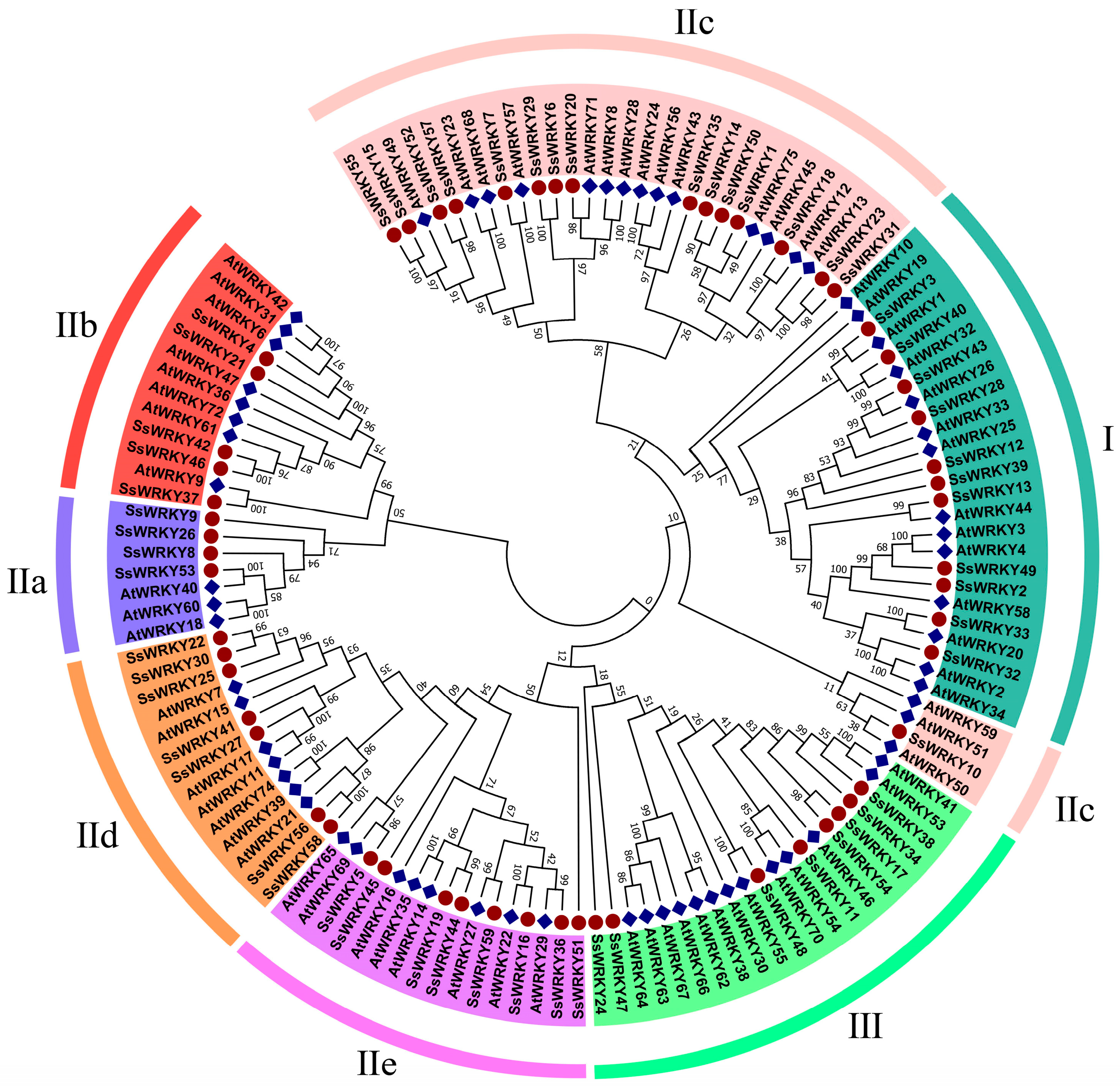
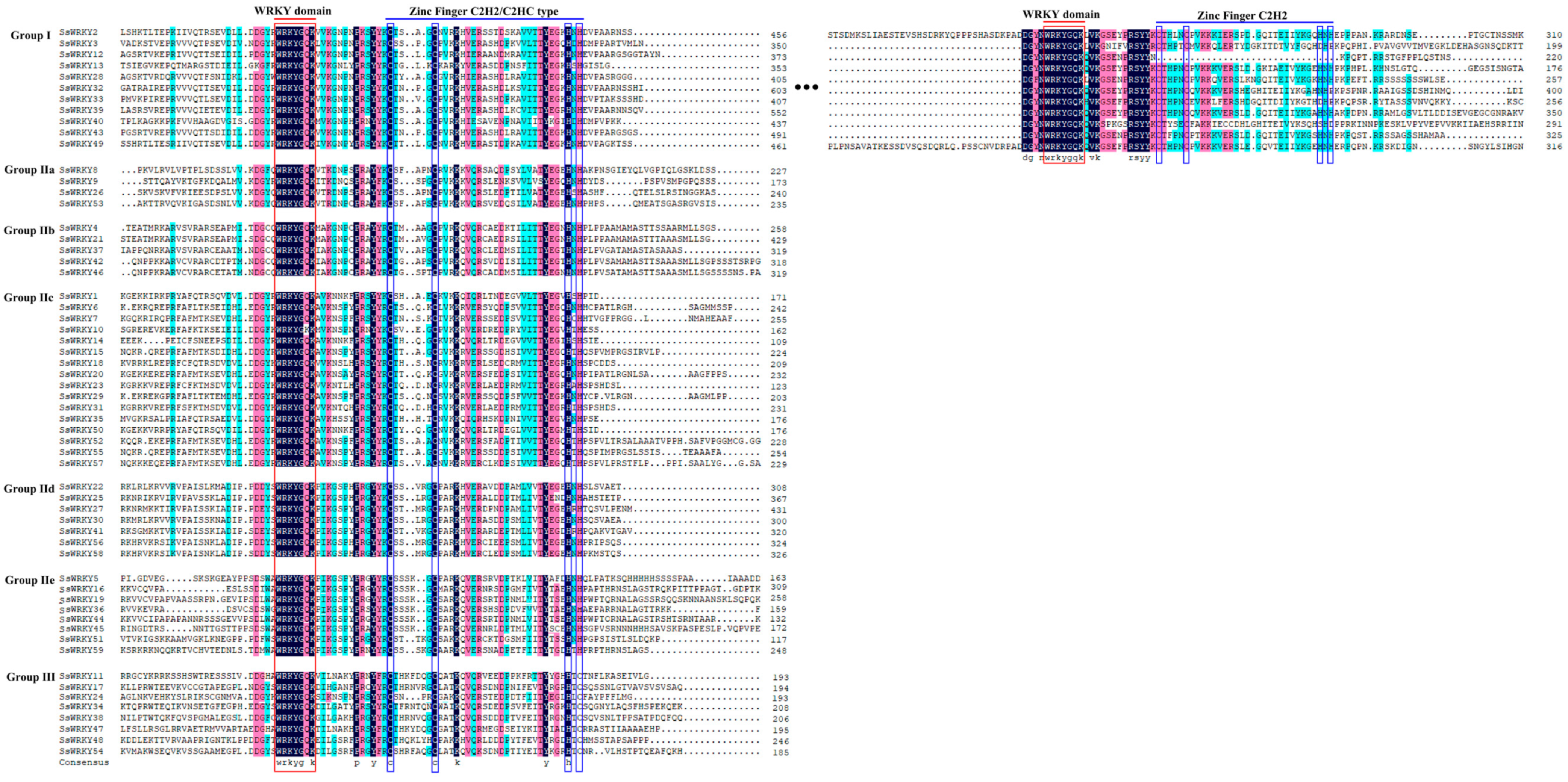
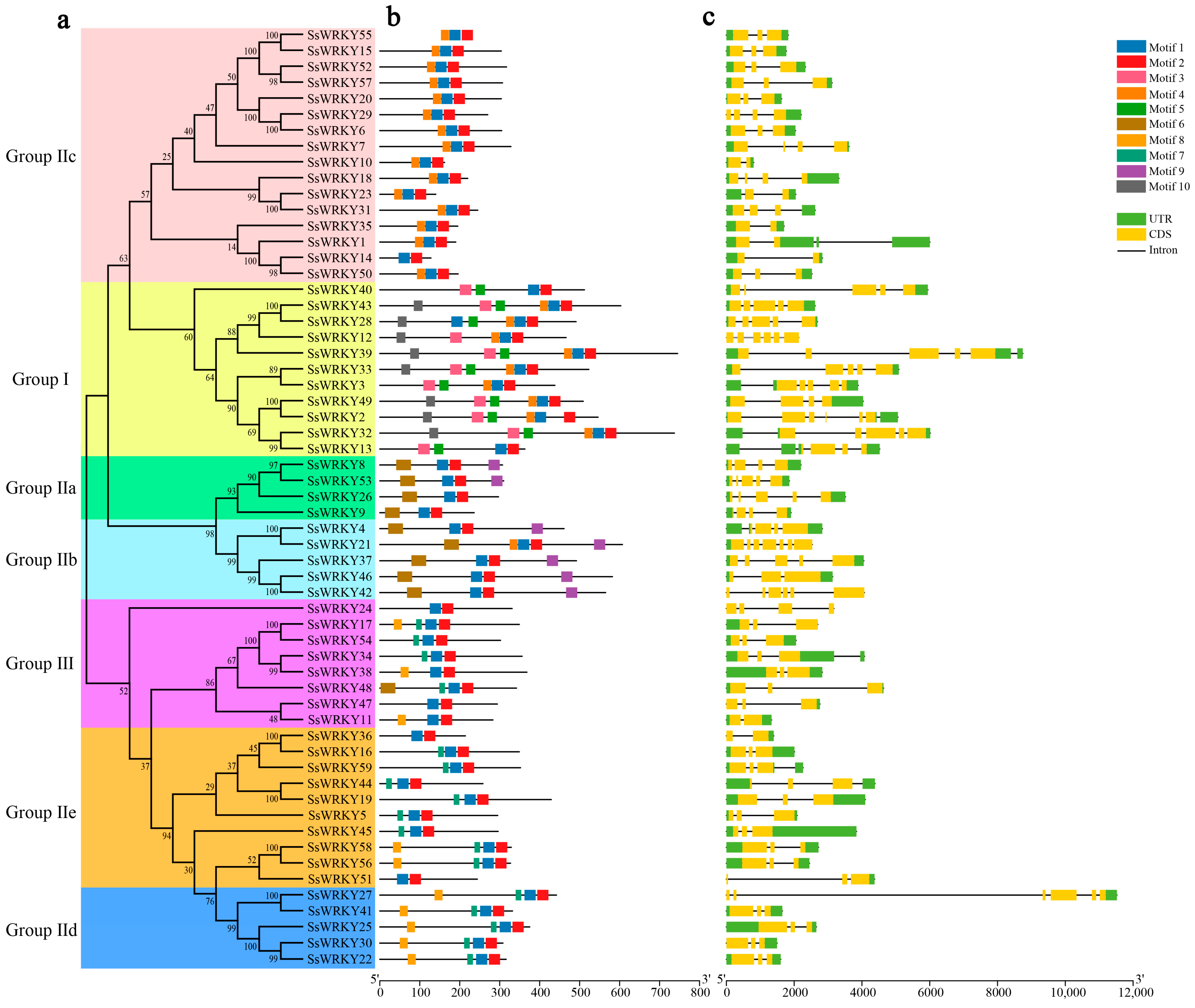
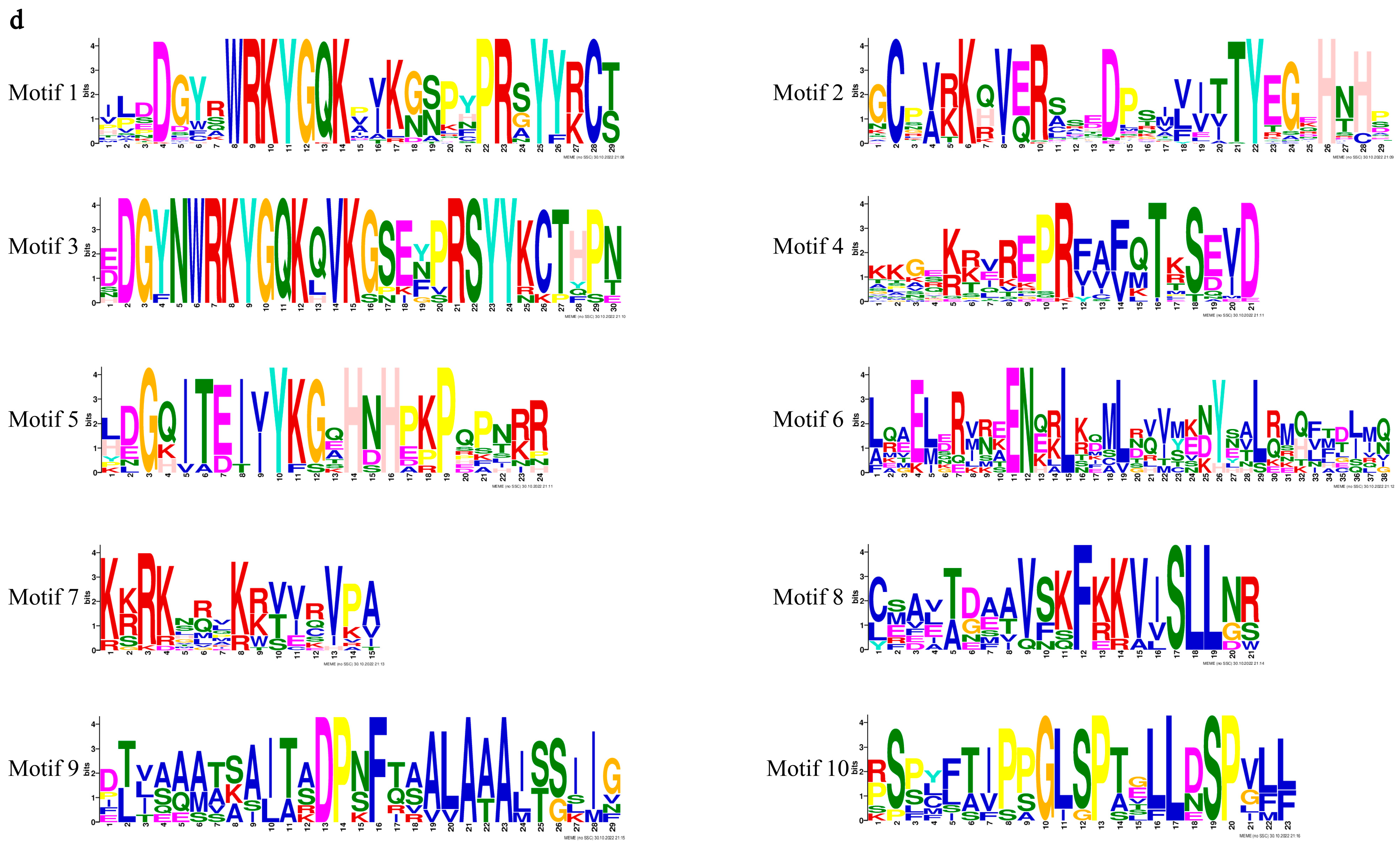
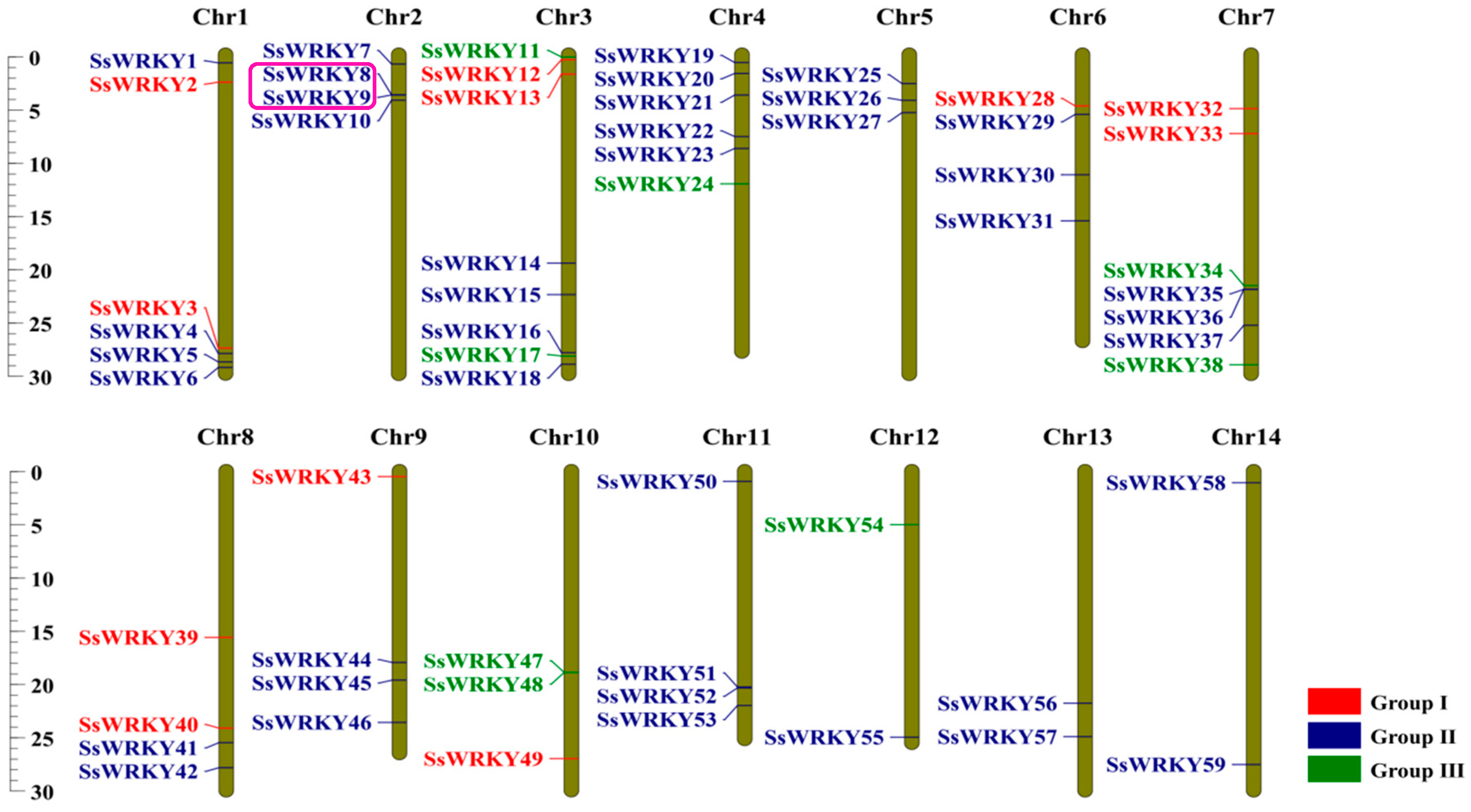
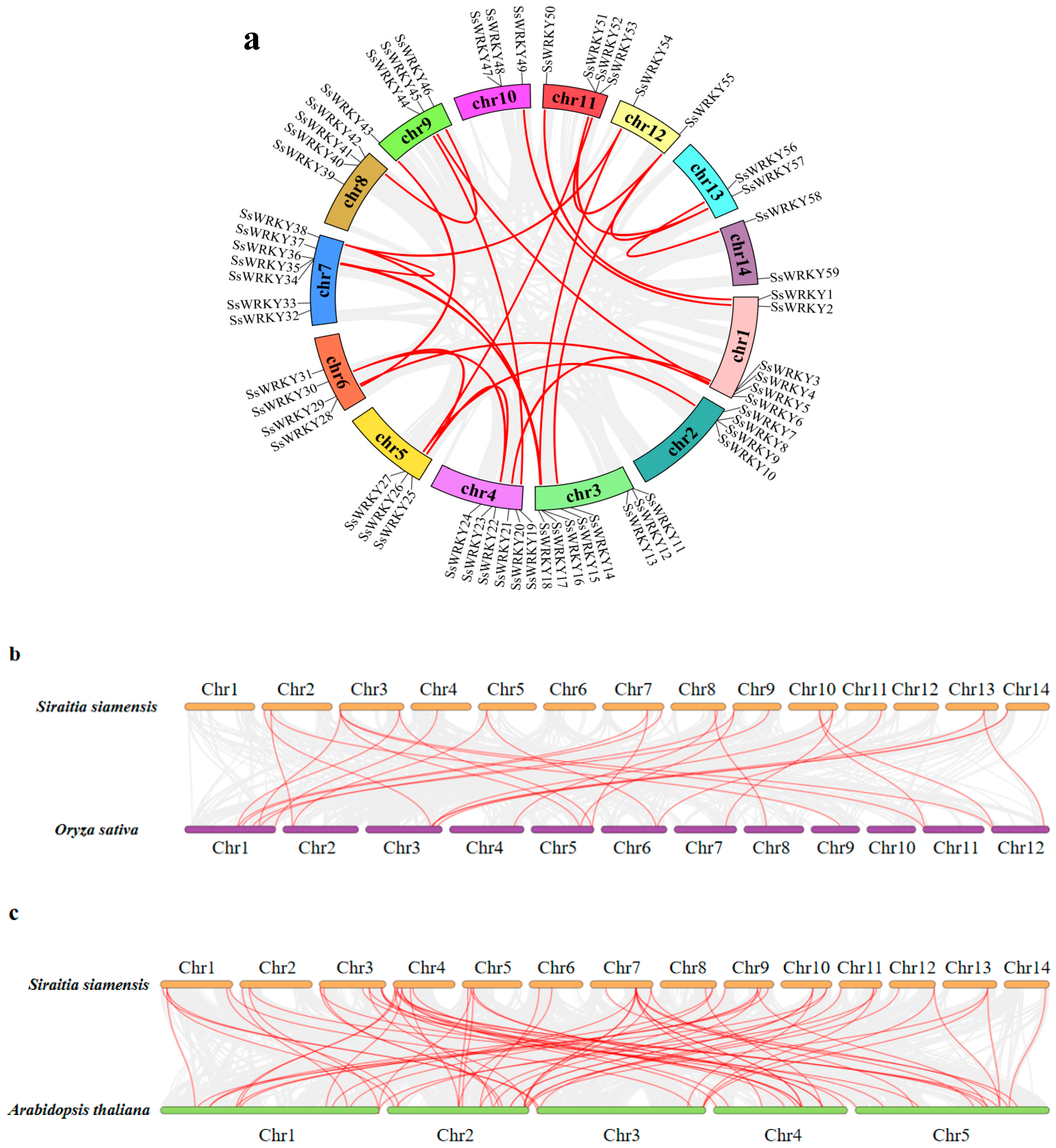

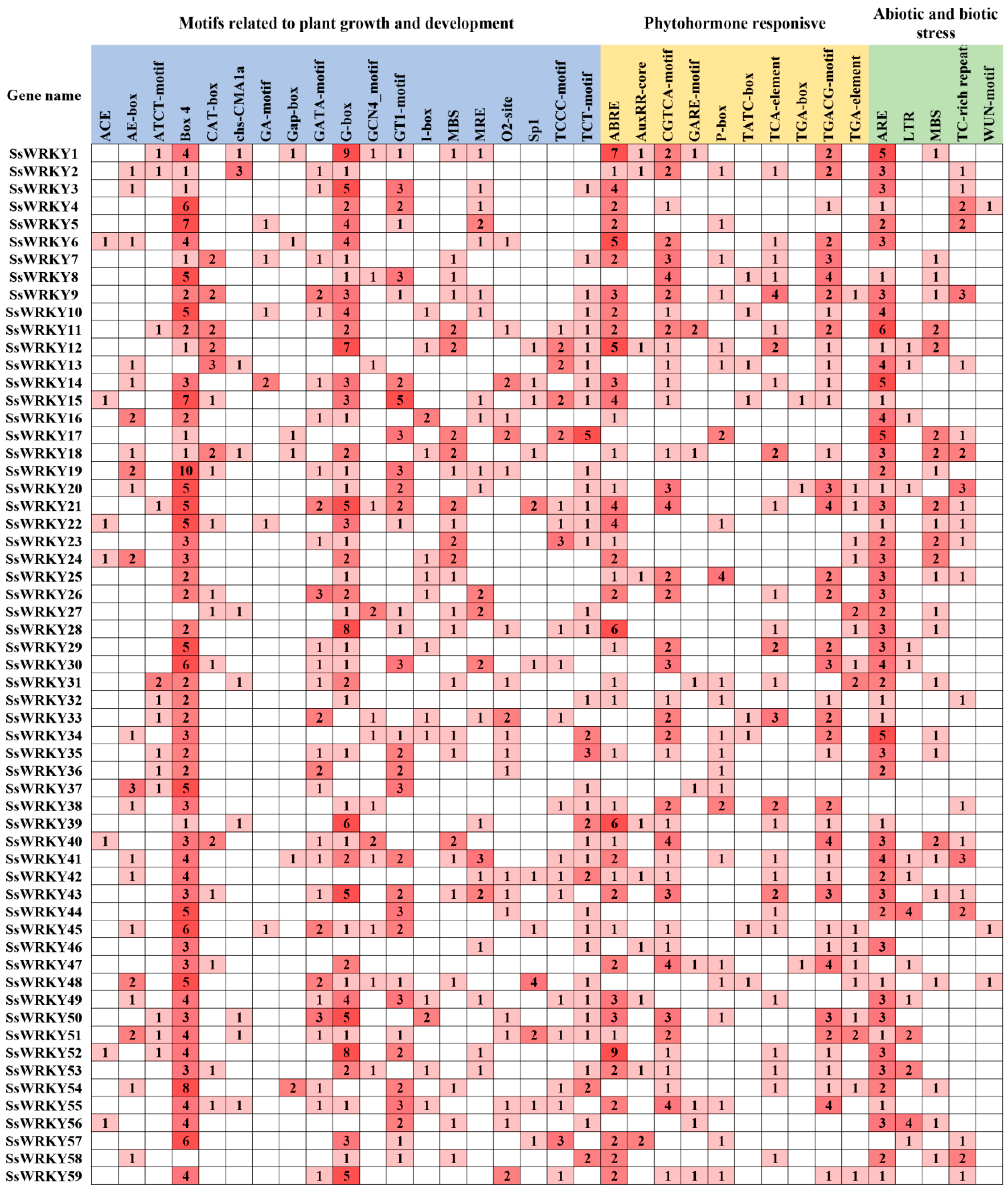
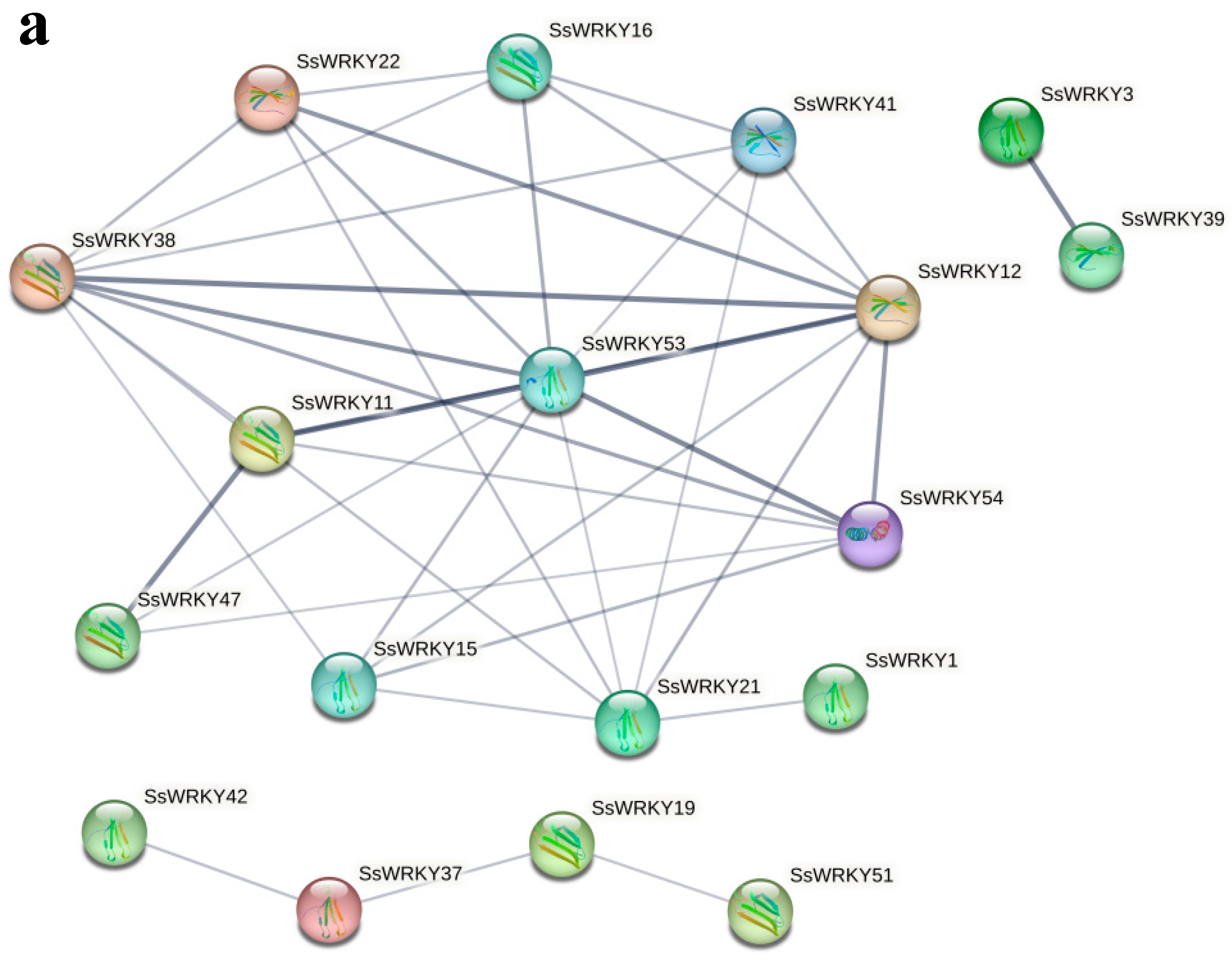
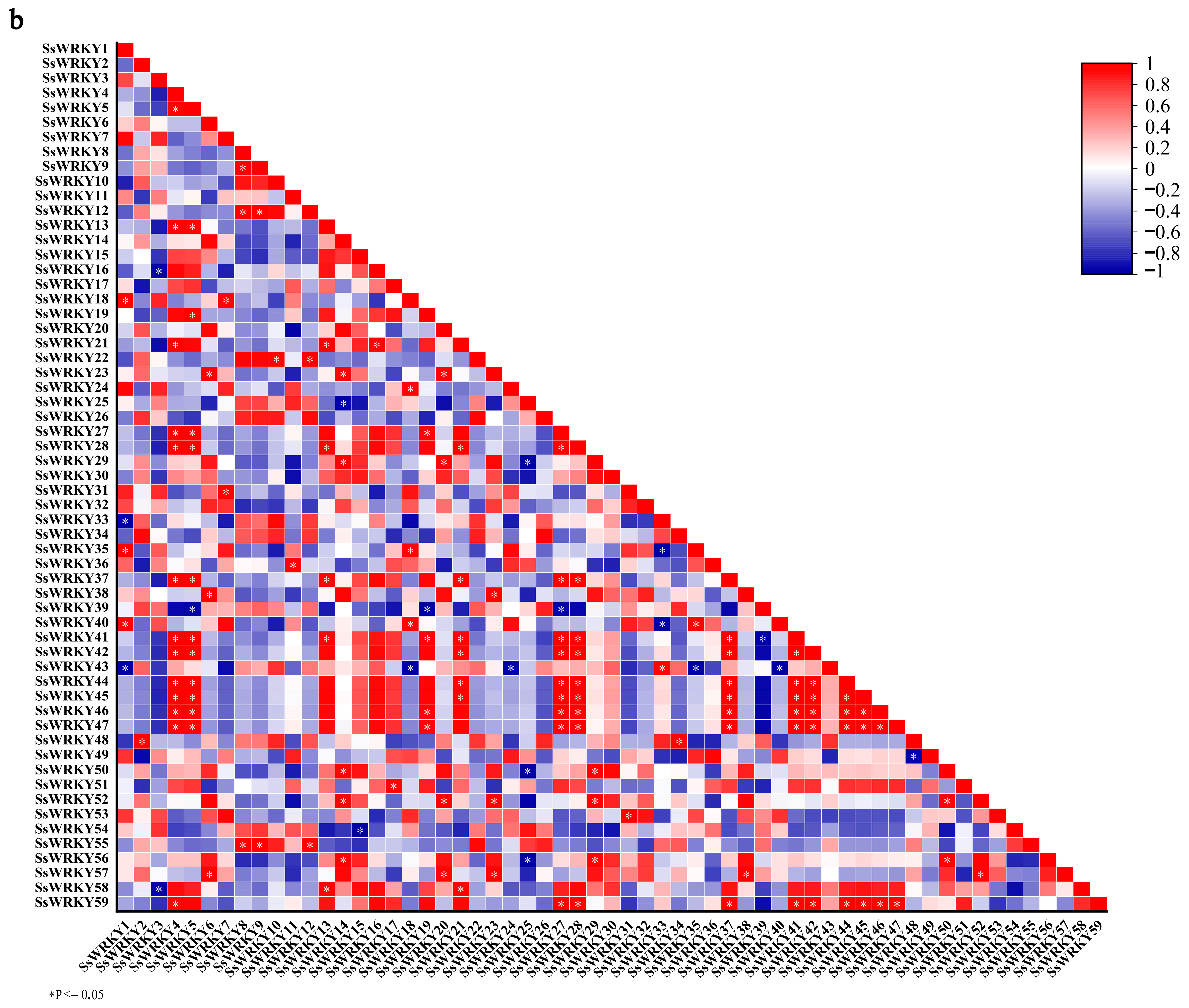

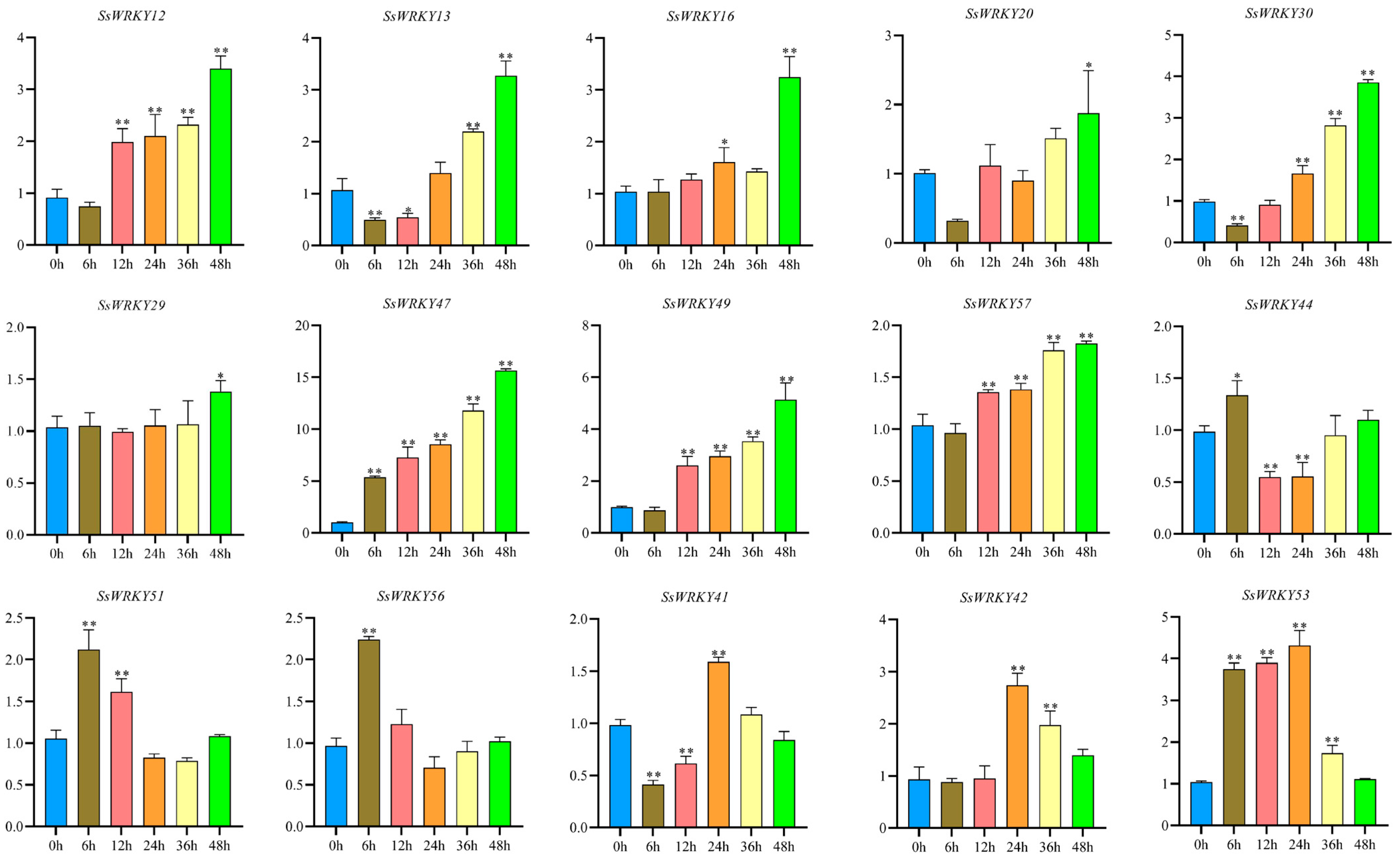
| Gene Name | Gene ID | Gene Start | Gene End | Protein Length (aa) | Molecular Weight | Theoretical pI | Instability Index | Subcellular Localization |
|---|---|---|---|---|---|---|---|---|
| SsWRKY1 | SsiaChr1G00020800.1 | 751919 | 757923 | 190 | 21,462.72 | 5.92 | 45.09 | nucleus |
| SsWRKY2 | SsiaChr1G00023090.1 | 2499410 | 2504472 | 546 | 60,090.33 | 7.67 | 58.86 | nucleus |
| SsWRKY3 | SsiaChr1G00040860.1 | 26599342 | 26603231 | 438 | 47,993.39 | 6.81 | 38.10 | nucleus |
| SsWRKY4 | SsiaChr1G00041580.1 | 27084596 | 27087427 | 461 | 49,397.04 | 8.40 | 45.55 | nucleus |
| SsWRKY5 | SsiaChr1G00042810.1 | 27853616 | 27855704 | 295 | 31,790.99 | 5.50 | 59.35 | nucleus |
| SsWRKY6 | SsiaChr1G00043600.1 | 28351114 | 28353153 | 305 | 34,321.93 | 7.10 | 71.15 | nucleus |
| SsWRKY7 | SsiaChr2G00001280.1 | 860173 | 863790 | 328 | 36,013.85 | 6.21 | 59.23 | nucleus |
| SsWRKY8 | SsiaChr2G00004890.1 | 3652228 | 3654428 | 307 | 33,802.91 | 8.57 | 45.82 | nucleus |
| SsWRKY9 | SsiaChr2G00004900.1 | 3661109 | 3663016 | 236 | 26,486.98 | 9.57 | 70.01 | nucleus |
| SsWRKY10 | SsiaChr2G00005450.1 | 4137409 | 4138214 | 162 | 18,458.21 | 5.17 | 39.23 | nucleus |
| SsWRKY11 | SsiaChr3G00044220.1 | 197881 | 199214 | 283 | 31,834.41 | 5.65 | 58.91 | nucleus |
| SsWRKY12 | SsiaChr3G00044550.1 | 429901 | 432039 | 466 | 50,804.16 | 6.15 | 61.60 | nucleus |
| SsWRKY13 | SsiaChr3G00046440.1 | 1628752 | 1633276 | 363 | 40,551.22 | 9.38 | 36.13 | nucleus |
| SsWRKY14 | SsiaChr3G00054430.1 | 17366784 | 17369617 | 128 | 14,590.29 | 6.90 | 57.03 | nucleus |
| SsWRKY15 | SsiaChr3G00056180.1 | 19990778 | 19992548 | 304 | 33,509.51 | 6.61 | 66.41 | nucleus |
| SsWRKY16 | SsiaChr3G00062240.1 | 24823802 | 24825812 | 349 | 37,785.78 | 5.70 | 58.09 | nucleus |
| SsWRKY17 | SsiaChr3G00062690.1 | 25101188 | 25103885 | 349 | 38,684.93 | 4.88 | 54.01 | nucleus |
| SsWRKY18 | SsiaChr3G00063680.1 | 25790770 | 25794091 | 220 | 24,863.42 | 8.74 | 45.10 | nucleus |
| SsWRKY19 | SsiaChr4G00082080.1 | 664352 | 668450 | 429 | 46,841.51 | 5.15 | 52.61 | nucleus |
| SsWRKY20 | SsiaChr4G00083060.1 | 1571966 | 1573595 | 304 | 33,330.52 | 5.93 | 52.89 | nucleus |
| SsWRKY21 | SsiaChr4G00085620.1 | 3371552 | 3374085 | 607 | 65,921.96 | 6.77 | 46.81 | nucleus |
| SsWRKY22 | SsiaChr4G00090590.1 | 6827223 | 6828826 | 316 | 34,224.58 | 9.59 | 37.56 | nucleus |
| SsWRKY23 | SsiaChr4G00091770.1 | 7817291 | 7819338 | 140 | 16,308.49 | 9.92 | 38.24 | nucleus |
| SsWRKY24 | SsiaChr4G00095300.1 | 10761531 | 10764705 | 331 | 36,407.8 | 9.15 | 67.77 | nucleus |
| SsWRKY25 | SsiaChr5G00105720.1 | 2172446 | 2175101 | 375 | 40,443.59 | 9.54 | 47.46 | nucleus |
| SsWRKY26 | SsiaChr5G00107540.1 | 3423281 | 3426794 | 297 | 34,150.07 | 9.39 | 51.45 | nucleus |
| SsWRKY27 | SsiaChr5G00108780.1 | 4344810 | 4356332 | 442 | 47,253.55 | 9.06 | 52.87 | nucleus |
| SsWRKY28 | SsiaChr6G00152850.1 | 3845799 | 3848486 | 491 | 54,198.42 | 9.11 | 61.97 | nucleus |
| SsWRKY29 | SsiaChr6G00153650.1 | 4474657 | 4476865 | 270 | 30,054.3 | 6.83 | 57.17 | nucleus |
| SsWRKY30 | SsiaChr6G00159600.1 | 8993505 | 8995000 | 308 | 33,360.81 | 9.38 | 51.73 | nucleus |
| SsWRKY31 | SsiaChr6G00161490.1 | 12439816 | 12442437 | 245 | 27,878.37 | 9.08 | 57.29 | nucleus |
| SsWRKY32 | SsiaChr7G00067510.1 | 4245861 | 4251877 | 737 | 79,659.14 | 5.94 | 55.04 | nucleus |
| SsWRKY33 | SsiaChr7G00068370.1 | 6214402 | 6219491 | 523 | 57,736.24 | 6.89 | 45.11 | nucleus |
| SsWRKY34 | SsiaChr7G00073090.1 | 18164282 | 18168358 | 356 | 40,012.95 | 5.73 | 59.24 | nucleus |
| SsWRKY35 | SsiaChr7G00073400.1 | 18453322 | 18455025 | 195 | 21,397.1 | 7.00 | 44.92 | nucleus |
| SsWRKY36 | SsiaChr7G00073410.1 | 18456961 | 18458359 | 214 | 24,010.52 | 4.95 | 58.25 | nucleus |
| SsWRKY37 | SsiaChr7G00076520.1 | 21283722 | 21287776 | 492 | 55,112.31 | 5.61 | 51.35 | nucleus |
| SsWRKY38 | SsiaChr7G00080620.1 | 24382740 | 24385570 | 368 | 40,365.31 | 5.82 | 50.80 | nucleus |
| SsWRKY39 | SsiaChr8G00123950.1 | 11741204 | 11749949 | 745 | 81,911.12 | 5.51 | 48.40 | nucleus |
| SsWRKY40 | SsiaChr8G00130410.1 | 18147025 | 18152970 | 512 | 56,211.49 | 6.28 | 57.55 | nucleus |
| SsWRKY41 | SsiaChr8G00131810.1 | 19170655 | 19172307 | 332 | 36,140.06 | 9.55 | 52.72 | nucleus |
| SsWRKY42 | SsiaChr8G00134260.1 | 20940110 | 20944180 | 565 | 60,663.57 | 6.89 | 59.63 | nucleus |
| SsWRKY43 | SsiaChr9G00178500.1 | 390249 | 392867 | 603 | 65,652.99 | 7.28 | 62.23 | nucleus |
| SsWRKY44 | SsiaChr9G00184810.1 | 13512314 | 13516697 | 258 | 28,929.78 | 6.15 | 44.44 | nucleus |
| SsWRKY45 | SsiaChr9G00186390.1 | 14756723 | 14760562 | 296 | 33,177.89 | 9.44 | 64.08 | nucleus |
| SsWRKY46 | SsiaChr9G00190810.1 | 17742607 | 17745742 | 582 | 62,261.62 | 6.87 | 41.80 | nucleus |
| SsWRKY47 | SsiaChr10G00168450.1 | 12831606 | 12834367 | 294 | 32,742.6 | 6.01 | 52.60 | nucleus |
| SsWRKY48 | SsiaChr10G00168460.1 | 12838628 | 12843264 | 342 | 37,504.25 | 7.07 | 51.72 | nucleus |
| SsWRKY49 | SsiaChr10G00175160.1 | 18327226 | 18331262 | 509 | 55,833.51 | 8.78 | 55.31 | nucleus |
| SsWRKY50 | SsiaChr11G00215290.1 | 661155 | 663681 | 196 | 21,975.74 | 9.28 | 31.80 | nucleus |
| SsWRKY51 | SsiaChr11G00221880.1 | 13766286 | 13770658 | 244 | 27,386.47 | 4.83 | 55.79 | nucleus |
| SsWRKY52 | SsiaChr11G00221950.1 | 13823287 | 13825620 | 317 | 34,872.95 | 6.06 | 54.27 | nucleus |
| SsWRKY53 | SsiaChr11G00223210.1 | 14943982 | 14945840 | 310 | 34,106.25 | 8.20 | 47.54 | nucleus |
| SsWRKY54 | SsiaChr12G00195640.1 | 3637484 | 3639541 | 302 | 33,579.64 | 5.30 | 50.52 | nucleus |
| SsWRKY55 | SsiaChr12G00203270.1 | 18044155 | 18045982 | 338 | 37,423.83 | 6.18 | 64.65 | nucleus |
| SsWRKY56 | SsiaChr13G00140450.1 | 15745104 | 15747555 | 327 | 36,421.34 | 9.65 | 62.67 | nucleus |
| SsWRKY57 | SsiaChr13G00142910.1 | 18011118 | 18014237 | 307 | 34,072.08 | 7.05 | 62.00 | nucleus |
| SsWRKY58 | SsiaChr14G00204380.1 | 659304 | 662023 | 329 | 36,799.93 | 9.69 | 47.81 | nucleus |
| SsWRKY59 | SsiaChr14G00213550.1 | 16567231 | 16569495 | 352 | 38,011.63 | 5.78 | 60.17 | nucleus |
Disclaimer/Publisher’s Note: The statements, opinions and data contained in all publications are solely those of the individual author(s) and contributor(s) and not of MDPI and/or the editor(s). MDPI and/or the editor(s) disclaim responsibility for any injury to people or property resulting from any ideas, methods, instructions or products referred to in the content. |
© 2023 by the authors. Licensee MDPI, Basel, Switzerland. This article is an open access article distributed under the terms and conditions of the Creative Commons Attribution (CC BY) license (https://creativecommons.org/licenses/by/4.0/).
Share and Cite
Mu, D.; Chen, W.; Shao, Y.; Wilson, I.W.; Zhao, H.; Luo, Z.; Lin, X.; He, J.; Zhang, Y.; Mo, C.; et al. Genome-Wide Identification and Expression Analysis of WRKY Transcription Factors in Siraitia siamensis. Plants 2023, 12, 288. https://doi.org/10.3390/plants12020288
Mu D, Chen W, Shao Y, Wilson IW, Zhao H, Luo Z, Lin X, He J, Zhang Y, Mo C, et al. Genome-Wide Identification and Expression Analysis of WRKY Transcription Factors in Siraitia siamensis. Plants. 2023; 12(2):288. https://doi.org/10.3390/plants12020288
Chicago/Turabian StyleMu, Detian, Wenqiang Chen, Yingying Shao, Iain W. Wilson, Huan Zhao, Zuliang Luo, Xiaodong Lin, Jialong He, Yuan Zhang, Changming Mo, and et al. 2023. "Genome-Wide Identification and Expression Analysis of WRKY Transcription Factors in Siraitia siamensis" Plants 12, no. 2: 288. https://doi.org/10.3390/plants12020288
APA StyleMu, D., Chen, W., Shao, Y., Wilson, I. W., Zhao, H., Luo, Z., Lin, X., He, J., Zhang, Y., Mo, C., Qiu, D., & Tang, Q. (2023). Genome-Wide Identification and Expression Analysis of WRKY Transcription Factors in Siraitia siamensis. Plants, 12(2), 288. https://doi.org/10.3390/plants12020288








